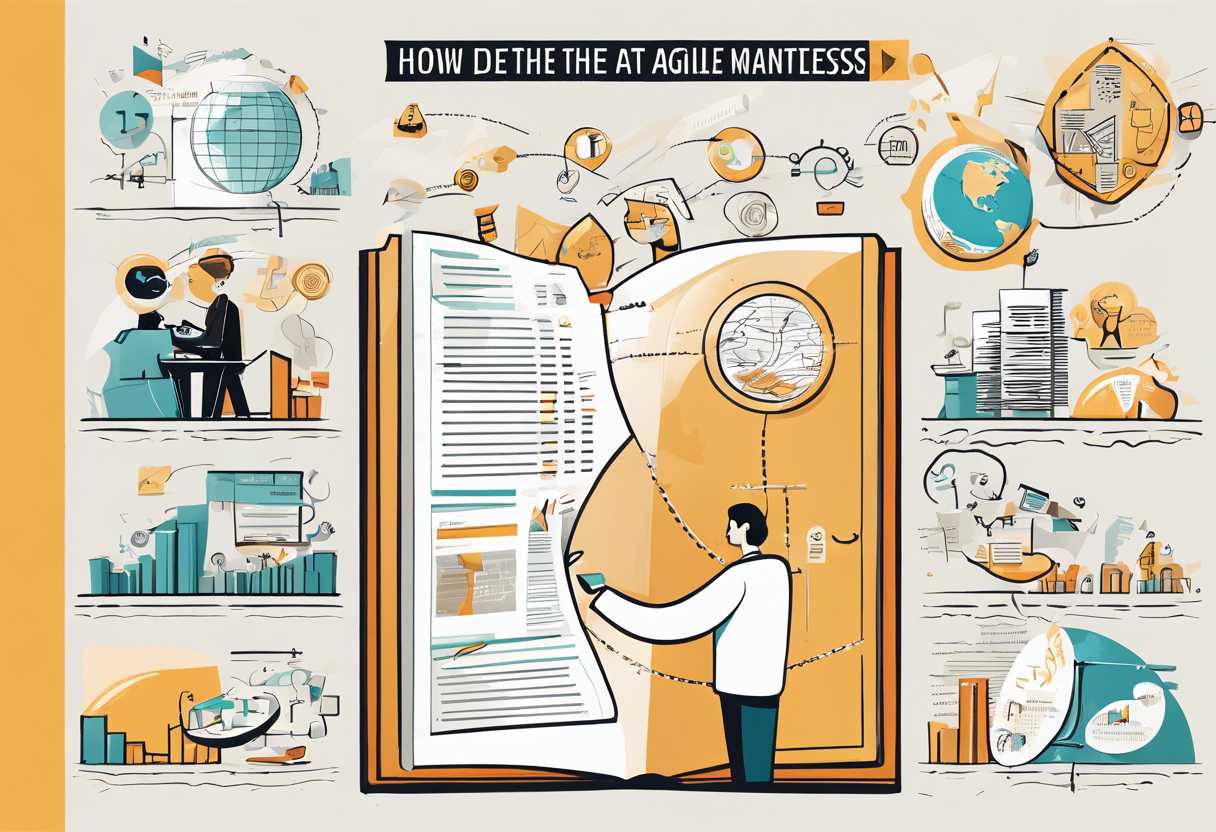Are you curious about how the Agile Manifesto addresses planning? In this blog post, we will delve into the key principles and approaches that the Agile Manifesto advocates for when it comes to planning. From understanding the Agile Manifesto’s approach to planning to embracing change and fostering collaborative planning, we will explore the role of flexibility, adaptability, and the balance between predictability and adaptability in Agile planning. Join us as we uncover the insights and perspectives that the Agile Manifesto offers on planning in the context of Agile methodologies.
Understanding the Agile Manifesto’s Approach to Planning
The Agile Manifesto: A Brief Overview
The Agile Manifesto is a set of guiding principles for software development that emphasizes flexibility, collaboration, and customer satisfaction. One of the key aspects of the Agile approach is its unique approach to planning, which differs significantly from traditional project management methodologies.
Iterative and Incremental Planning
Agile planning is based on the principles of iterative and incremental development. This means that instead of creating a detailed plan at the beginning of a project and sticking to it rigidly, Agile teams work in short cycles, continuously refining and adjusting their plans based on feedback and changing requirements. *This flexible approach allows teams to adapt to evolving circumstances and deliver value to the customer more effectively.*
Embracing Change and Uncertainty
Unlike traditional project management methods that aim to eliminate uncertainty and change, Agile planning embraces them as natural aspects of software development. *Agile teams understand that requirements will evolve, and unexpected challenges will arise, so they prioritize adaptability and responsiveness over strict adherence to a predefined plan.* This mindset allows Agile teams to stay nimble and responsive, delivering high-quality products that meet the customer’s needs.

The Role of Flexibility and Adaptability in Agile Planning
Adapting to Change
One of the key principles of agile planning is the ability to adapt to change. In today’s fast-paced business environment, it’s crucial for organizations to be able to pivot quickly in response to new information, market shifts, or unexpected challenges. This requires a high degree of flexibility and adaptability within the planning process.
Embracing Iterative Processes
Agile planning relies on iterative processes, where plans are continuously reviewed and adjusted based on feedback and new insights. This iterative approach allows for greater flexibility, as it enables teams to make changes as needed without disrupting the entire project. By embracing this iterative mindset, organizations can better respond to changing circumstances and ensure that their plans remain relevant and effective.
Collaboration and Communication
Flexibility and adaptability in agile planning also rely on strong collaboration and communication within teams. When team members are able to openly share ideas, concerns, and feedback, it becomes easier to identify areas for improvement and make necessary adjustments. This collaborative approach fosters a culture of adaptability, where everyone is invested in the success of the plan and willing to make changes as needed.

Embracing Change: Agile Manifesto’s Perspective on Planning
The Agile Manifesto’s View on Planning
The Agile Manifesto emphasizes the importance of responding to change over following a plan. This perspective acknowledges that in today’s fast-paced and dynamic business environment, plans are often outdated as soon as they are created. Instead, Agile promotes flexibility and adaptability, allowing teams to adjust their plans as new information and challenges arise.
Benefits of Embracing Change in Planning
By embracing change in planning, organizations can stay ahead of the curve and respond more effectively to market shifts and customer needs. This approach fosters innovation and creativity, as teams are encouraged to continuously improve and refine their plans based on real-time feedback and insights. Additionally, embracing change in planning can lead to faster delivery of value to customers, as teams are empowered to make quick decisions and adjustments as needed.
Implementing Agile Planning Practices
When implementing Agile planning practices, it’s important to prioritize collaboration and communication within the team. This allows for a shared understanding of goals and priorities, enabling team members to work together towards a common vision. Additionally, Agile planning involves breaking down work into smaller, manageable chunks, known as iterations or sprints. This iterative approach allows for regular checkpoints and adjustments, ensuring that plans remain relevant and aligned with the organization’s objectives.
Collaborative Planning in Agile: A Key Principle of the Manifesto
The Importance of Collaborative Planning
Collaborative planning is a fundamental principle of Agile methodology, emphasizing the importance of involving all team members in the planning process. This approach ensures that everyone has a clear understanding of the project goals, timelines, and deliverables, leading to better alignment and buy-in from all stakeholders. By fostering collaboration, Agile teams can leverage the diverse expertise and perspectives of team members to create more robust and innovative plans.
Benefits of Collaborative Planning
When teams embrace collaborative planning in Agile, they experience several benefits. First and foremost, it promotes transparency and accountability, as all team members have a voice in the planning process and take ownership of the outcomes. Additionally, collaborative planning encourages continuous improvement, as team members can identify potential risks and opportunities early on and adjust their plans accordingly. This proactive approach leads to more efficient and effective project execution, ultimately driving better results for the organization.
Best Practices for Collaborative Planning
Implementing collaborative planning in Agile requires a deliberate and inclusive approach. To maximize the benefits of collaborative planning, teams should prioritize open communication, active participation, and a willingness to embrace diverse viewpoints. It’s also essential to establish clear roles and responsibilities within the planning process, ensuring that everyone understands their contributions and commitments. By fostering a culture of collaboration and inclusivity, teams can harness the power of collective intelligence to drive successful project outcomes.
Understanding the Balance
When it comes to agile planning, finding the right balance between predictability and adaptability is crucial for success. Predictability allows teams to plan and execute with confidence, while adaptability enables them to respond to changes and uncertainties. Striking the right balance between the two is essential for achieving project goals and delivering value to customers.
The Importance of Predictability
Predictability in agile planning refers to the ability to forecast and plan for future outcomes with a reasonable degree of certainty. This is essential for setting realistic expectations, managing resources effectively, and meeting deadlines. Predictability provides stakeholders with confidence in the team’s ability to deliver on commitments, which is crucial for building trust and maintaining strong relationships.
The Need for Adaptability
Adaptability in agile planning is the capacity to adjust and respond to changes in requirements, market conditions, and other external factors. This flexibility is essential for staying responsive to customer needs, seizing new opportunities, and mitigating risks. By embracing adaptability, teams can remain agile and resilient in the face of uncertainty, ultimately leading to better outcomes and customer satisfaction.
Finding the Right Balance
Striking the right balance between predictability and adaptability requires a thoughtful approach that considers the unique needs and challenges of each project. It involves leveraging predictability to establish a solid foundation for planning and execution, while also embracing adaptability to remain responsive and agile in the face of change. By finding this equilibrium, teams can achieve a harmonious blend of stability and flexibility, ultimately leading to successful outcomes.
Conclusion
In conclusion, the Agile Manifesto offers a unique and effective approach to planning that prioritizes flexibility, adaptability, and collaboration. By understanding the Agile Manifesto’s perspective on planning, organizations can embrace change and achieve a balance between predictability and adaptability. The role of flexibility and adaptability in Agile planning allows teams to respond to evolving requirements and deliver value to customers more effectively.
Embracing change is a fundamental principle of the Agile Manifesto, and it encourages teams to welcome new ideas and adjust their plans accordingly. Collaborative planning is another key principle of the Manifesto, emphasizing the importance of involving all stakeholders in the planning process to ensure alignment and shared understanding.
Ultimately, Agile planning enables organizations to achieve a balance between predictability and adaptability, allowing them to respond to changing market conditions and customer needs while maintaining a clear direction and focus. By embracing the principles of the Agile Manifesto, teams can improve their planning processes and deliver better results for their customers.
As you continue your Agile journey, we encourage you to apply the principles of the Agile Manifesto to your planning processes and embrace the benefits of flexibility, adaptability, and collaboration. By doing so, you can unlock the full potential of Agile planning and drive greater success for your organization.
Thank you for reading, and we hope this blog has provided valuable insights into how the Agile Manifesto addresses planning.

